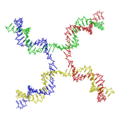Chromosomal crossover
Chromosomal crossover is a vital process that occurs during meiosis, a type of cell division that produces gametes in sexually reproducing organisms. This process contributes to genetic diversity by exchanging DNA between two homologous chromosomes, resulting in recombination of genetic material.
Overview[edit]
Chromosomal crossover, also known as recombination, is a natural process that occurs during the prophase I stage of meiosis. It involves the exchange of genetic material between two homologous chromosomes, which are a pair of maternal and paternal chromosomes that pair up during meiosis.
Process[edit]
The process of chromosomal crossover begins when the two homologous chromosomes pair up in a process known as synapsis. During synapsis, the chromosomes come into close contact and form a structure known as a tetrad.
Following synapsis, the chromosomes undergo a process known as crossing over. During crossing over, the two chromosomes exchange segments of their DNA. This exchange of genetic material results in the recombination of genetic material, creating new combinations of genes that were not present in the parent organisms.
Significance[edit]
Chromosomal crossover plays a crucial role in the evolution and diversity of species. By creating new combinations of genes, it contributes to the genetic variation within a population. This genetic variation is the raw material for natural selection, allowing populations to adapt to changing environments.
Chromosomal crossover also ensures the proper segregation of chromosomes during meiosis. Without crossover, homologous chromosomes may not segregate properly, leading to the production of gametes with an incorrect number of chromosomes, a condition known as aneuploidy.
See also[edit]
-
Chromosomal crossover illustration
-
Morgan crossover example 1
-
Morgan crossover example 2
-
Homologous recombination process
-
Holliday junction diagram
-
Holliday junction photograph
-
Coloured Holliday junction
-
Conversion and crossover
Ad. Transform your life with W8MD's Budget GLP-1 injections from $75


W8MD offers a medical weight loss program to lose weight in Philadelphia. Our physician-supervised medical weight loss provides:
- Weight loss injections in NYC (generic and brand names):
- Zepbound / Mounjaro, Wegovy / Ozempic, Saxenda
- Most insurances accepted or discounted self-pay rates. We will obtain insurance prior authorizations if needed.
- Generic GLP1 weight loss injections from $75 for the starting dose.
- Also offer prescription weight loss medications including Phentermine, Qsymia, Diethylpropion, Contrave etc.
NYC weight loss doctor appointmentsNYC weight loss doctor appointments
Start your NYC weight loss journey today at our NYC medical weight loss and Philadelphia medical weight loss clinics.
- Call 718-946-5500 to lose weight in NYC or for medical weight loss in Philadelphia 215-676-2334.
- Tags:NYC medical weight loss, Philadelphia lose weight Zepbound NYC, Budget GLP1 weight loss injections, Wegovy Philadelphia, Wegovy NYC, Philadelphia medical weight loss, Brookly weight loss and Wegovy NYC
|
WikiMD's Wellness Encyclopedia |
| Let Food Be Thy Medicine Medicine Thy Food - Hippocrates |
Medical Disclaimer: WikiMD is not a substitute for professional medical advice. The information on WikiMD is provided as an information resource only, may be incorrect, outdated or misleading, and is not to be used or relied on for any diagnostic or treatment purposes. Please consult your health care provider before making any healthcare decisions or for guidance about a specific medical condition. WikiMD expressly disclaims responsibility, and shall have no liability, for any damages, loss, injury, or liability whatsoever suffered as a result of your reliance on the information contained in this site. By visiting this site you agree to the foregoing terms and conditions, which may from time to time be changed or supplemented by WikiMD. If you do not agree to the foregoing terms and conditions, you should not enter or use this site. See full disclaimer.
Credits:Most images are courtesy of Wikimedia commons, and templates, categories Wikipedia, licensed under CC BY SA or similar.
Translate this page: - East Asian
中文,
日本,
한국어,
South Asian
हिन्दी,
தமிழ்,
తెలుగు,
Urdu,
ಕನ್ನಡ,
Southeast Asian
Indonesian,
Vietnamese,
Thai,
မြန်မာဘာသာ,
বাংলা
European
español,
Deutsch,
français,
Greek,
português do Brasil,
polski,
română,
русский,
Nederlands,
norsk,
svenska,
suomi,
Italian
Middle Eastern & African
عربى,
Turkish,
Persian,
Hebrew,
Afrikaans,
isiZulu,
Kiswahili,
Other
Bulgarian,
Hungarian,
Czech,
Swedish,
മലയാളം,
मराठी,
ਪੰਜਾਬੀ,
ગુજરાતી,
Portuguese,
Ukrainian








